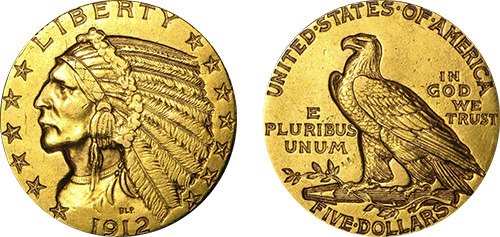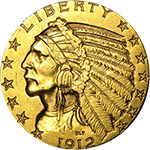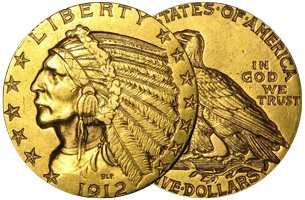Like all $5 gold coins produced by the U.S. Mint, the Indian Head $5 gold coin is also called a half eagle. This Indian Head coin was struck from 1908 to 1929, but production was stopped between 1917 and 1928. One revolutionary thing about the design of this coin is that the images are all recessed instead of raised. No American coins had ever been designed or produced like this before, which means that Indian Head coins wear a bit differently than most coins. However, this can complicate coin grading for collectors who are used to judging the grade of raised designs.
According to the NCG, this coin can be found in lower mint state grades but is very rare in what is called “gem quality” grades like MS-65. In 1914, the Philadelphia Mint only produced 247,000 of these coins, which was much smaller than previous mintages. After 1916, the Mint halted production due to World War I. Production was resumed again in 1929, but ceased entirely that same year when the Great Depression hit the country.
American coinage was undergoing a major overhaul under President Theodore Roosevelt. After the redesign for the double eagle and the eagle, he also wanted to restyle the smaller denominations. The idea for sunken images came a close friend of Roosevelt’s, Boston physician William Sturgis Bigelow. An admirer of Egyptian art, Bigelow had been inspired after seeing this type of recessed relief used in Egyptian art at a Boston museum. After obtaining Roosevelt’s permission, Bigelow engaged a sculptor named Bela Lyon Pratt to create the first designs. That’s why these types of half dollars are sometimes called Pratt-Bigelow coins.

As a result of Bigelow’s original idea, the Native American men on the obverse and the American Eagle on the reverse side of the coin have slightly ancient Egyptian look to them. The obverse side also features 13 stars, representing the initial 13 colonies, as well as the engraving “LIBERTY,” the initials “BLP,” and the mint year. Aside from the eagle, the reverse side includes the engravings “UNITED STATES OF AMERICA,” “E PLURIBUS UNUM,” “IN GOD WE TRUST,” and the denomination “FIVE DOLLARS.”
The $5 Indian head coin consists of 90% gold and 10% copper.
While $5 gold coins may seem relatively redundant these days, they could be useful during those early years of the 20th Century. For example, famous car manufacturer Henry Ford raised his workers’ pay from an average of less than $2.50 a day to $5 a day in 1914, which was a good daily wage then. In a time before most people had checking accounts, this proved to be a convenient way of receiving one’s pay. However, half eagle coins did not circulate as much as eagle or double eagle coins.
Interestingly enough, the NGC specifications page lists the gold melt value of this coin at just about $281 in August of 2015 – an amount that can be considered a very good daily wage in this day and age. The numismatic value of these coins, even in circulated condition, is of course considerably higher than the face value. Even though the half eagle has never been as coveted as the quarter eagle (one of the rarest 20th century American gold coins in higher grades), its precious metal content and historical value render it an attractive option for both gold investors and coin collectors. Moreover, there are 24 different half eagle coins by date and mintmark, and some coins are virtually impossible to find.


